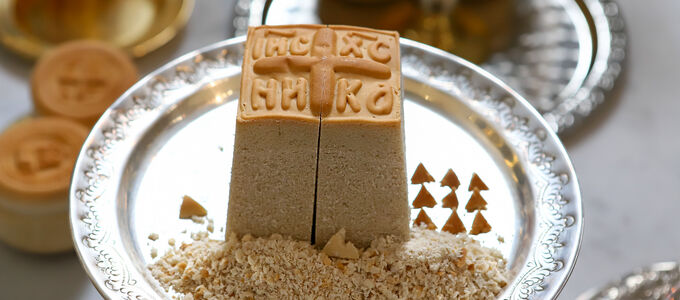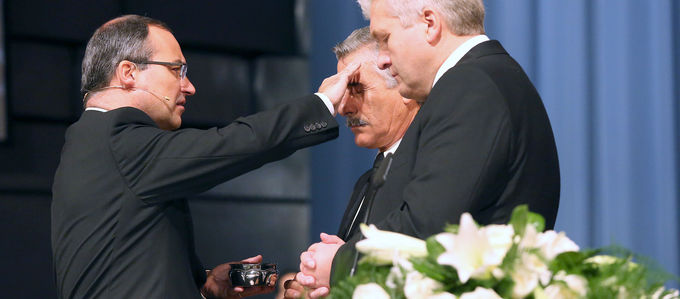The sacraments (41): Is Holy Sealing merely a New Apostolic phenomenon?

What distinguishes the New Apostolic doctrine from that of other faiths? This question and others like it come up time and again. Depending on the context, the answer to this question can be longer or shorter. But most often it involves one key concept: Holy Sealing.
The New Apostolic Church acknowledges three sacraments. And just because that is the case—and just because other churches may have more or fewer sacraments—it is by no means a cult! In terms of its content, Holy Sealing is also quite at home in other denominations, even if it is labelled differently there. It is actually a biblical act that none of the churches can ignore.
According to the New Apostolic Catechism, Holy Sealing is “the sacrament through which the believer, through the laying on of hands and the prayer of an Apostle, receives the gift of the Holy Spirit and becomes a child of God with the calling to become a firstling”. That is an important statement, not least of all because it touches on the very foundations of Christian faith. Jesus was anointed, and the Apostles and individual believers were sealed with the Holy Spirit. Later on, the Church established an order for receiving the sacraments. However, this had already been mapped out in the New Testament: “These accounts indicate that, apart from the exceptions mentioned, the gift of the Holy Spirit was solely administered by Apostles. Furthermore, it becomes clear that the gift of the Holy Spirit was dispensed only after baptism with water had been administered,” states the Catechism .
Origin and development
Naturally, this was not always the case. The Catholic Apostolic Church, which emerged in the 1830s, understood Holy Sealing more in terms of a “certification” of a previously performed baptism. While this may at first sound like a marginal difference, it is not. The act, which was likewise described as an “apostolic laying on of hands”, was performed on adults from the age of 21. Through this act, it was taught that the believer received the fullness of the Spirit. Accordingly, baptism with water was understood as the opening sacrament that made human beings into Christians and children of God. Holy Sealing—which was first introduced liturgically in 1847—simply certified this step. Just as in the act of confirmation, the baptised believer was thus assured of the accompaniment and help of God and His Apostles.
Later on, the sacrament was given something of an upgrade in that it was emphasised as relevant for salvation in its character of rebirth out of water and the Spirit—with a reference to biblical events and specifications. Baptism with water was now seen as being “completed” by the act of Holy Sealing, resulting in a sacrament of two parts that belong together, as both of them collectively constitute the rebirth. Concerning this, the New Apostolic Catechism: states the following: “That which was begun in Holy Baptism is completed in Holy Sealing, namely the rebirth out of water and Spirit. Both sacraments are acts of God’s grace upon a human being and are only performed once. The life received thereby is nourished and preserved above all by regularly partaking of Holy Communion. The new creation (2 Corinthians 5: 17), which comes into being through the rebirth, is a reference to the sanctification and renewal which occurs through God, the Holy Spirit.”
Why Holy Sealing?
Above all, it is important to believe in the significance and purpose of this sacrament. Why did Holy Sealing even become a sacrament? Why and how do Holy Baptism and Holy Sealing belong together? Here too, our New Apostolic forefathers succeeded in finding a meaningful answer: while Holy Baptism with water incorporates human beings into the church of Christ, the baptism of the Spirit is the believer’s ticket into the bridal congregation of the Lord. It is there that the imminently awaited return of Jesus Christ is preached, and that the Apostles prepare the congregation of firstfruits: “Through the rebirth out of water and Spirit, the believer is moreover called by God to become a firstling. With respect to the kingdom of God, the rebirth has both a present and future aspect (John 3: 5). The present effect of the rebirth—the childhood in God—represents, as it were, an anticipation of being a firstling and part of the ‘royal priesthood’ (1 Peter 2: 9) … The surrender to Christ begun in Holy Baptism with water is completed in Holy Sealing. The believer thereby receives that spiritual revival which will lead him into fellowship with the returning Lord (James 1: 18; Revelation 14: 4). Accordingly, the believer now belongs to that group within the church whom God prepares through Apostles for the return of Christ and the marriage in heaven (Revelation 19: 7–8)” (CNAC 8.3.9).
In future issues of our series on the sacraments we will explore the story of how this sacrament developed over the course of the many years of Church history, how it ultimately became an important hallmark of New Apostolic doctrine, and what other denominations have to say about it.
Johnstocker – stock.adobe.com














